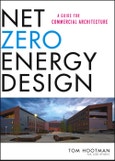Conveniently organized and packed with robust technical content and clear explanations of key principles
Written by an architect who is the director of sustainability at a global architecture firm, Net Zero Energy Design is a practical guide for architects and related construction professionals who want to design and build net zero energy commercial architecture. It offers no-nonsense strategies, step-by-step technical analysis, and valuable examples, in addition to developed case studies. With a focus on application in a variety of building types and scales, the book also develops a broad-based understanding of all the integrated principles involved in achieving net zero energy.
This book is an indispensable resource for anyone venturing into net zero energy design, construction, and operation, and it also serves as an excellent resource on a variety of sustainable design topics. Important features include:
- Organization based upon the commercial building delivery process
- Robust technical content for use in actual project applications
- Analysis examples that demonstrate key technical principles
- Plenty of design data for use as a valuable design resource
- Abundant and sophisticated information graphics and color illustrations and photographs
- A distinct design focus on the content that inspires adoption of principles into projects
Table of Contents
Acknowledgments IX
In Introduction xiii
My Net Zero Energy Journey XIII
How To Use This Book xi v
OV Chapter 1: Net Zero Energy Building
Overview 1
The Case for Net Zero Energy Buildings 1
Defining Net Zero Energy 4
Classifying Net Zero Energy Buildings 10
Alternative Approaches to Net Zero Energy 12
Certifying Net Zero Energy Buildings 15
Building Industry Research and Trends 16
Building Industry Programs 19
Building Industry Codes and Regulations 20
Building Rating and Energy Labeling Systems 23
PC Chapter 2: Project Conception and Delivery 27
The Net Zero Energy Objective 27
Project Conception 36
Project Planning 40
Project Team Selection 44
Delivery Methods 49
Risks and Rewards 53
IP Chapter 3: Integrated Process 57
Integrated Delivery and Management 57
Project Delivery Phases 63
Integrated Design Methods 69
Building Energy Modeling 73
En Chapter 4: Energy 89
Energy Basics 89
Energy Use Intensity 102
Energy Targets 109
Energy and Thermal Comfort 125
DF Chapter 5: Design Fundamentals 133
Energy Design Conditions 133
Climate Assessment 133
Site Assessment 158
Building Massing and Geometry 166
Building Type and Zoning 177
PA Chapter 6: Pa ssive Architecture 183
Passive Design 183
Design Science 186
Building Envelope 202
Passive Strategies 215
EE Chapter 7: Energy-Efficient Building Systems 231
Active Systems 231
Basic Concepts 235
HVAC Overview 240
Low-Energy Distribution 243
Low-Energy Primary Equipment 247
Domestic Hot Water 256
Lighting 258
District Energy 266
RE Chapter 8: Renewab le Energy 271
Renewable Energy Basics 271
Solar Power 272
Solar Thermal 284
Wind 293
Hydro 300
Geothermal 306
Biomass 309
Fuel Cells and Hydrogen 314
Ec Chapter 9: Economics 319
Financial Considerations 319
Financial Models 329
Financial Analysis 333
Net Zero Energy and the Real Estate Market 341
OO Chapter 10: Operations and Occupancy 347
Building Operation 347
Plug Loads 352
Green Behavior 357
Net Zero Energy Performance Plan 363
NZ Chapter 11: Net Zero Energy 367
Net Zero Energy Balance 367
Net Zero Energy Measures 367
Carbon Neutrality 377
CS Chapter 12: Case Study: DOE /NREL Research Support Facility 387
Introduction 387
Process 388
Project Economics 389
Climate, Site, and Program 391
Design Response 394
Operation and Occupancy 406
Performance Metrics 411
Bib liography 417
About the Author 427
Index 429








